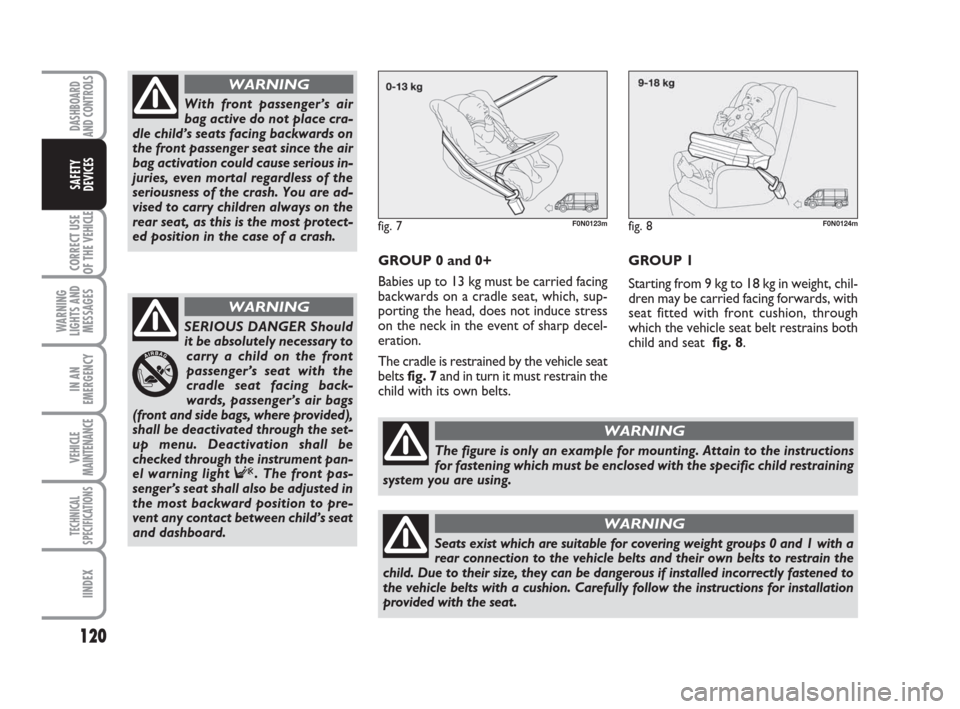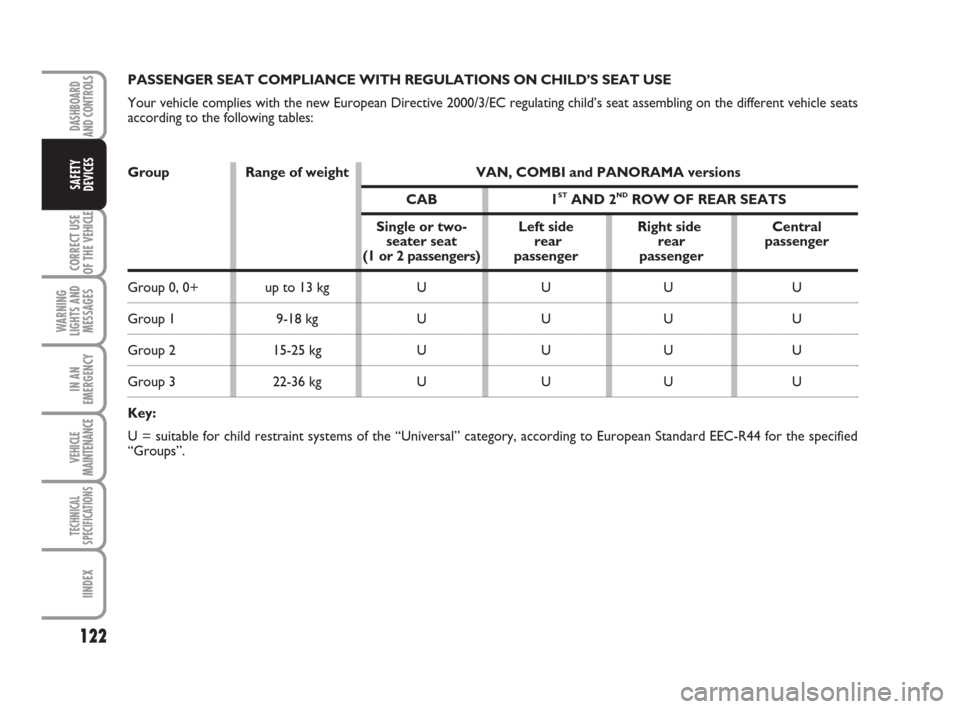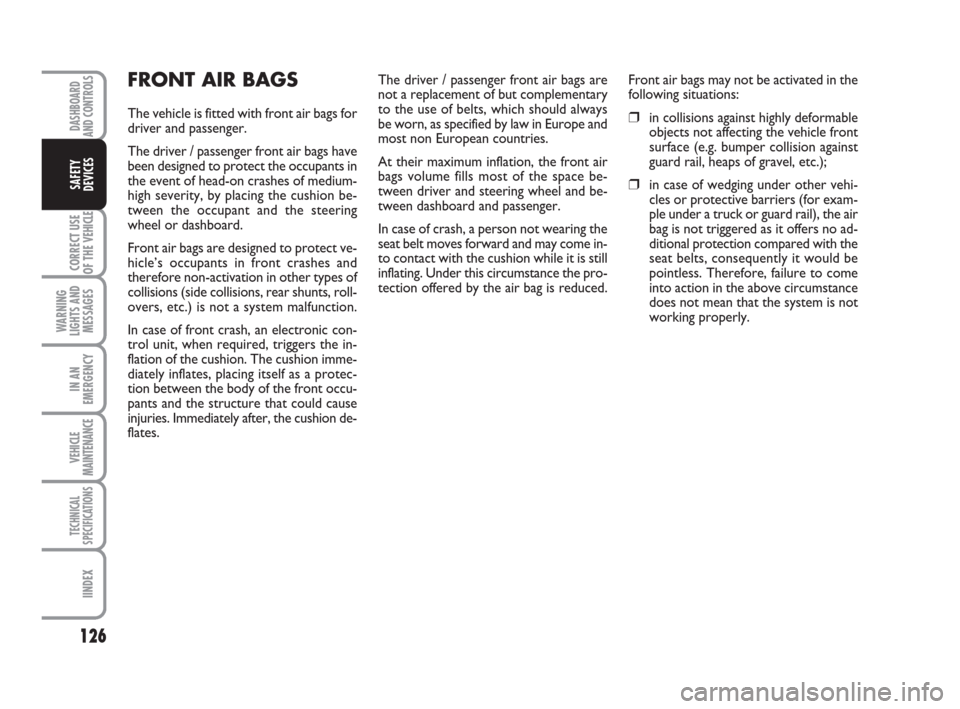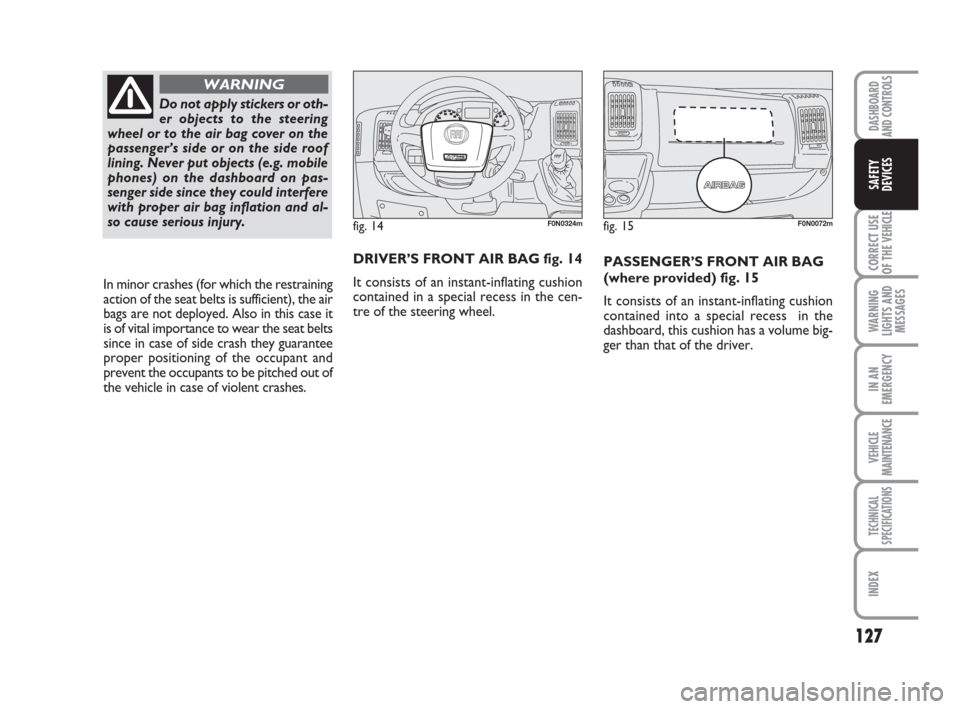2009 FIAT DUCATO side lights
[x] Cancel search: side lightsPage 113 of 282

112
SAFETY
DEVICES
CORRECT USE
OF THE
VEHICLE
WARNING
LIGHTS AND
MESSAGES
IN AN
EMERGENCY
VEHICLE
MAINTENANCE
TECHNICAL
SPECIFICATIONS
INDEX
DASHBOARD
AND CONTROLS
During normal service the
diesel particulate filter (DPF)
reaches high temperatures. Do not
therefore park the car over inflam-
mable materials (grass, dry leaves,
pine needles, etc.): fire hazard.
WARNING
PROTECTING
THE ENVIRONMENT
The devices for curtailing diesel fuel en-
gine emissions are the following:
❒oxidising catalytic converter;
❒exhaust gas recirculation system
(E.G.R.);
❒diesel particulate filter (DPF).
During normal service the
catalyst reaches high tem-
peratures. Do not therefore park the
car over inflammable materials (grass,
dry leaves, pine needles, etc.): fire
hazard.
WARNING
DIESEL PARTICULATE FILTER
(DPF)
The Diesel Particulate Filter is a mechan-
ical filter, integral with the exhaust system,
that physically traps particulates present
in the exhaust gases of Diesel engines.
The diesel particular filter has been adopt-
ed to eliminate almost totally particulates
in compliance with current / future law
regulations.
During normal use of the car, the engine
control unit records a set of data (e.g.:
travel time, type of route, temperatures,
etc.) and it will then calculate how much
particulates has been trapped by the filter.
Since this filter physically traps particulates,
it shall be cleaned (reclaimed) at regular
intervals by burning carbon particles.
Reclaiming procedure is controlled auto-
matically by the engine control unit ac-
cording to the filter conditions and the
conditions of use of the car.During reclaiming the following phenomena
could take place: idling slight increase, fan ac-
tivation, slight smoke increase, high exhaust
temperatures. These situations shall not be
considered as faults and they do not affect
car performance and environment.
If the dedicated message is displayed, refer to
section “Warning lights and messages”.
Page 114 of 282

113
CORRECT USE
OF THE
VEHICLE
WARNING
LIGHTS AND
MESSAGES
IN AN
EMERGENCY
VEHICLE
MAINTENANCE
TECHNICAL
SPECIFICATIONS
INDEX
DASHBOARD
AND CONTROLS
SAFETY
DEVICES
SEAT BELTS ........................................................................... 113
S.B.R. SYSTEM ....................................................................... 114
PRETENSIONERS.................................................................. 115
CARRYING CHILDREN SAFELY...................................... 119
PRESETTING FOR MOUNTING THE
“UNIVERSAL ISOFIX” CHILD RESTRAINT
SYSTEM.................................................................................... 124
FRONT AIR BAGS................................................................ 126
SIDE AIR BAGS .................................................................... 128
SS S
A A
F F
E E
T T
Y Y
D D
E E
V V
I I
C C
E E
S S
Page 120 of 282

HOW TO KEEP THE SEAT
BELTS ALWAYS IN EFFICIENT
CONDITIONS
Observe the following:
❒always use the belt with the tap taut
and never twisted; make sure that it
is free to run without impediments;
❒after a serious accident, replace the
belt being worn at that time, even if it
does not appear damaged. Always re-
place the seat belts if pretensioners
have been activated;
❒to clean the belts, wash by hand with
neutral soap, rinse and leave to dry in
the shade. Never use strong deter-
gents, bleach or dyes or other chem-
ical substance that might weaken the
fibres;
❒prevent the reels from getting wet:
their correct operation is only guar-
anteed if water does not get inside;
❒replace the seat belt when showing
significant wear or cut signs.For optimal protection in the event of a
crash, all passengers must be seated and
wearing adequate restraint systems.
This is even more important for children.
This prescription is compulsory in all EC
countries according to EC Directive
2003/20/EC.
Compared with adults, their head is pro-
portionally larger and heavier than the rest
of the body, while the muscles and bone
structure are not completely developed.
Therefore, correct restraint systems are
necessary, other than adult seat belts. The
results of research on the best child re-
straint systems are contained in the Euro-
pean Standard EEC-R44. This Standard en-
forces the use of restraint systems classi-
fied in five groups:Group 0 0-10 kg in weight
Group 0+ 0-13 kg in weight
Group 1 9-18 kg in weight
Group 2 15-25 kg in weight
Group 3 22-36 kg in weight
As it may be noted, the groups overlap
partly and in fact, in commerce it is pos-
sible to find devices that cover more than
one weight group.
All restraint devices must bear the certi-
fication data, together with the control
brand, on a solidly fixed label which must
absolutely never be removed.
Over 1.50 m in height, from the point of
view of restraint systems, children are
considered as adults and wear the seat
belts normally.
119
CORRECT USE
OF THE
VEHICLE
WARNING
LIGHTS AND
MESSAGES
IN AN
EMERGENCY
VEHICLE
MAINTENANCE
TECHNICAL
SPECIFICATIONS
INDEX
DASHBOARD
AND CONTROLS
SAFETY
DEVICES
CARRYING CHILDREN SAFELY
Page 121 of 282

120
CORRECT USE
OF THE
VEHICLE
WARNING
LIGHTS AND
MESSAGES
IN AN
EMERGENCY
VEHICLE
MAINTENANCE
TECHNICAL
SPECIFICATIONS
IINDEX
DASHBOARD
AND CONTROLS
SAFETY
DEVICES
GROUP 0 and 0+
Babies up to 13 kg must be carried facing
backwards on a cradle seat, which, sup-
porting the head, does not induce stress
on the neck in the event of sharp decel-
eration.
The cradle is restrained by the vehicle seat
belts fig. 7and in turn it must restrain the
child with its own belts.
With front passenger’s air
bag active do not place cra-
dle child’s seats facing backwards on
the front passenger seat since the air
bag activation could cause serious in-
juries, even mortal regardless of the
seriousness of the crash. You are ad-
vised to carry children always on the
rear seat, as this is the most protect-
ed position in the case of a crash.
WARNING
SERIOUS DANGER Should
it be absolutely necessary to
carry a child on the front
passenger’s seat with the
cradle seat facing back-
wards, passenger’s air bags
(front and side bags, where provided),
shall be deactivated through the set-
up menu. Deactivation shall be
checked through the instrument pan-
el warning light F. The front pas-
senger’s seat shall also be adjusted in
the most backward position to pre-
vent any contact between child’s seat
and dashboard.
WARNING
fig. 7F0N0123m
The figure is only an example for mounting. Attain to the instructions
for fastening which must be enclosed with the specific child restraining
system you are using.
WARNING
Seats exist which are suitable for covering weight groups 0 and 1 with a
rear connection to the vehicle belts and their own belts to restrain the
child. Due to their size, they can be dangerous if installed incorrectly fastened to
the vehicle belts with a cushion. Carefully follow the instructions for installation
provided with the seat.
WARNING
fig. 8F0N0124m
GROUP 1
Starting from 9 kg to 18 kg in weight, chil-
dren may be carried facing forwards, with
seat fitted with front cushion, through
which the vehicle seat belt restrains both
child and seat fig. 8.
Page 123 of 282

122
CORRECT USE
OF THE
VEHICLE
WARNING
LIGHTS AND
MESSAGES
IN AN
EMERGENCY
VEHICLE
MAINTENANCE
TECHNICAL
SPECIFICATIONS
IINDEX
DASHBOARD
AND CONTROLS
SAFETY
DEVICES
PASSENGER SEAT COMPLIANCE WITH REGULATIONS ON CHILD’S SEAT USE
Your vehicle complies with the new European Directive 2000/3/EC regulating child’s seat assembling on the different vehicle seats
according to the following tables:
Group Range of weight VAN, COMBI and PANORAMA versions
CAB 1STAND 2NDROW OF REAR SEATS
Single or two- Left side Right side Central
seater seat rear rear passenger
(1 or 2 passengers) passenger passenger
Group 0, 0+ up to 13 kg U U U U
Group 1 9-18 kg U U U U
Group 2 15-25 kg U U U U
Group 3 22-36 kg U U U U
Key:
U = suitable for child restraint systems of the “Universal” category, according to European Standard EEC-R44 for the specified
“Groups”.
Page 126 of 282

PASSENGER SEAT COMPLIANCE WITH REGULATIONS ON UNIVERSAL ISOFIX CHILD’S SEAT USE
The table below, according to ECE 16 European Directive, shows the different installation possibilities of Universal Isofix restraint
systems on seats fitted with Isofix fasteners.
125
CORRECT USE
OF THE
VEHICLE
WARNING
LIGHTS AND
MESSAGES
IN AN
EMERGENCY
VEHICLE
MAINTENANCE
TECHNICAL
SPECIFICATIONS
INDEX
DASHBOARD
AND CONTROLS
SAFETY
DEVICES
F
G
E
E
D
C
D
C
B1
A Facing backwards
Facing backwards
Facing backwards
Facing backwards
Facing backwards
Facing backwards
Facing backwards
Facing forwards
Facing forwards
Facing forwardsIUF
IUF
IUF
IUF
IUF
IUF
IUF
IUF(*)
IUF
IUFIUF
IUF
IUF
IUF
IUF
IUF(*)
IUF
IUF(*)
IUF
IUF
Range of weight Child’s seat Isofix Vehicle Isofix positions
orientation class side rear side rear 1strowPANORAMA COMBI
Portable cradle
Group 0 to 10 kg
Group 0+ to 13 kg
Group I - 9
to 18 kg
(*) No with front two-seat bench
IUF: suitable for Isofix child restraint systems to be set facing forwards, universal class (fitted with third upper fastener), approved
for the weight group.
Page 127 of 282

FRONT AIR BAGS
The vehicle is fitted with front air bags for
driver and passenger.
The driver / passenger front air bags have
been designed to protect the occupants in
the event of head-on crashes of medium-
high severity, by placing the cushion be-
tween the occupant and the steering
wheel or dashboard.
Front air bags are designed to protect ve-
hicle’s occupants in front crashes and
therefore non-activation in other types of
collisions (side collisions, rear shunts, roll-
overs, etc.) is not a system malfunction.
In case of front crash, an electronic con-
trol unit, when required, triggers the in-
flation of the cushion. The cushion imme-
diately inflates, placing itself as a protec-
tion between the body of the front occu-
pants and the structure that could cause
injuries. Immediately after, the cushion de-
flates.
126
CORRECT USE
OF THE
VEHICLE
WARNING
LIGHTS AND
MESSAGES
IN AN
EMERGENCY
VEHICLE
MAINTENANCE
TECHNICAL
SPECIFICATIONS
IINDEX
DASHBOARD
AND CONTROLS
SAFETY
DEVICES
The driver / passenger front air bags are
not a replacement of but complementary
to the use of belts, which should always
be worn, as specified by law in Europe and
most non European countries.
At their maximum inflation, the front air
bags volume fills most of the space be-
tween driver and steering wheel and be-
tween dashboard and passenger.
In case of crash, a person not wearing the
seat belt moves forward and may come in-
to contact with the cushion while it is still
inflating. Under this circumstance the pro-
tection offered by the air bag is reduced.Front air bags may not be activated in the
following situations:
❒in collisions against highly deformable
objects not affecting the vehicle front
surface (e.g. bumper collision against
guard rail, heaps of gravel, etc.);
❒in case of wedging under other vehi-
cles or protective barriers (for exam-
ple under a truck or guard rail), the air
bag is not triggered as it offers no ad-
ditional protection compared with the
seat belts, consequently it would be
pointless. Therefore, failure to come
into action in the above circumstance
does not mean that the system is not
working properly.
Page 128 of 282

127
CORRECT USE
OF THE
VEHICLE
WARNING
LIGHTS AND
MESSAGES
IN AN
EMERGENCY
VEHICLE
MAINTENANCE
TECHNICAL
SPECIFICATIONS
INDEX
DASHBOARD
AND CONTROLS
SAFETY
DEVICES
PASSENGER’S FRONT AIR BAG
(where provided) fig. 15
It consists of an instant-inflating cushion
contained into a special recess in the
dashboard, this cushion has a volume big-
ger than that of the driver.
fig. 14F0N0324mfig. 15F0N0072m
DRIVER’S FRONT AIR BAG fig. 14
It consists of an instant-inflating cushion
contained in a special recess in the cen-
tre of the steering wheel.
Do not apply stickers or oth-
er objects to the steering
wheel or to the air bag cover on the
passenger’s side or on the side roof
lining. Never put objects (e.g. mobile
phones) on the dashboard on pas-
senger side since they could interfere
with proper air bag inflation and al-
so cause serious injury.
WARNING
In minor crashes (for which the restraining
action of the seat belts is sufficient), the air
bags are not deployed. Also in this case it
is of vital importance to wear the seat belts
since in case of side crash they guarantee
proper positioning of the occupant and
prevent the occupants to be pitched out of
the vehicle in case of violent crashes.